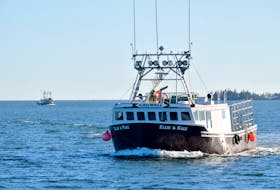AMHERST, N.S. – The effort to protect a vital transportation corridor along the Tantramar Marsh from rising sea levels has received a significant boost.
Cumberland-Colchester MP Bill Casey was in Amherst on Monday to announce a $700,000 study that will explore viable options to climate change impacts on the Chignecto Isthmus trade corridor that links Nova Scotia and New Brunswick.
The federal government is providing $350,000 for the study through its $2-billion, 11-year Trade and Transportation Initiative while the governments of New Brunswick and Nova Scotia are each providing $175,000.
“This is the first step in a lot of steps to address this issue,” Casey said after making the announcement. “It’s important that we take the steps before the disaster happens because once a disaster happens it’ll be extremely difficult to fix. The only chance to do it reasonably and not interfere with our transportation links is to do it sooner. It’s not a matter of if it’s going to happen, it’s when it’s going to happen.”
Casey, who has been working on the issue since 2009, said climate change, specifically rising sea levels and storm surges, pose a significant risk to critical infrastructure along the Isthmus of Chignecto and the Tantramar marshes that run between Amherst and Sackville, N.B.
RELATED
- Editorial: Weather watch
- Who is going to fix dikes on the Tantramar Marsh?
- Advocate Harbour residents concerned about future of dike protecting community
The study will involve a comprehensive engineering assessment of existing infrastructure, consultation with stakeholders and options to protect and sustain the trade corridor that includes both the CN rail line connecting the Port of Halifax to the rest of the continent and the Trans-Canada Highway, along with transmission lines and agricultural dikes.
He said the two provincial governments will issue the tenders for the study, but he could not say when the tenders will be called or when the study will be completed.
The MP said the isthmus is a vital transportation corridor that carries an estimated $50 million in trade per day.

Casey said the CN rail line holds back the ocean and the highway linking the two provinces is below sea level. If the dikes are breached, it could cause havoc with the province’s economy and that of Newfoundland and Labrador that ships a lot of its product by highway through Nova Scotia to the rest of Canada.
“The study will identify exactly what the challenges are, where the vulnerable areas are and what are the fixes,” Casey said. “It’s not going to be a cheap fix, but it’s going to be a vital one.”
Amherst Mayor Dave Kogon said the fact it was one of the first applications approved by Ottawa shows how important the issue is.
“They know this problem is extremely real and threatening,” the mayor said. “To me, it’s a shoo-in that they’re going to implement whatever the engineering study says needs to be done.”
The mayor said a good portion of the town, and that of Sackville, N.B., sits within the flood plain. If something happens to the dikes, he fears much of the town could be underwater.
He appreciates that the provinces have been working on the issue before he and other municipal leaders first raised the issue several months ago with Casey and New Brunswick MP and cabinet minister Dominic LeBlanc.
“It’s not going to be a cheap fix, but it’s going to be a vital one.”
MP Bill Casey
“If you look at the maps at how big a surge or rising sea levels could be you’ll find that as much as 30 per cent of the town is in the flood plain,” the mayor said. “Sackville has a similar problem. Whatever plan comes into play as far as a fix it has to be something that also protects Amherst.”
Cumberland County’s EMO co-ordinator Mike Johnson said the study will go a long way toward mitigating or addressing any breach or topping of the dike. It’s something he said is going to happen, possibly as early as 2100.
“I’m glad they’re moving as quickly as they are because this is something we have to address,” Johnson said. “We could have a storm next month with high tide. We don’t know when it’s going to happen. With climate change we’re having more severe storms and with sea level rise there’s the risk of the dikes being overcome.”
Johnson said an eight-metre storm surge similar to the Saxby Gaile of 1869 would come over the top of the dikes and make the Trans-Canada Highway and the rail line impassable. He has suggested that either increasing the height of the dikes or moving the highway and/or rail line are some of the options to be considered.
Cumberland County Warden Allison Gillis said a lot of key infrastructure for his municipality is also threatened, including areas along the marsh in Fort Lawrence. That includes valuable agricultural land.
“This could have a tremendous negative impact if we do nothing to address the risk and then have something happen,” Gillis said. “It’s not something we can afford to wait on. This is very good news for all of our municipalities.”
Last fall, Kogon and Gillis met with the Sackville, N.B., mayor and MPs Casey and LeBlanc to express concerns about the dikes and to begin what they hoped would be the process to upgrade the infrastructure along the marsh.
Twitter: @ADNdarrell
READ MORE
- Editorial: Weather watch
- Who is going to fix dikes on the Tantramar Marsh?
- Funding for dike study could come next month
- NDP calling for funding for Chignecto isthmus dikes
- Dike risk at centre of Advocate Harbour public meeting
- Mayors along NB/NS border calling on government to take action on dikes
- Threat to dikes is real, says Cumberland County's EMO co-ordinator
- Dike risk at centre of Advocate Harbour public meeting
- Research scientist’s maps show how sea level rise will affect Nova Scotia communities
- EDITORIAL: Not a question of if, but when
- Casey, LeBlanc meet with municipal officials about Fundy sea levels
- ‘King tides’ of today to be norm in the future










